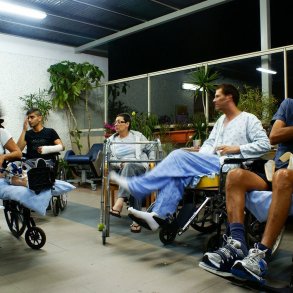By Nick Parker and Lisa Gill for Enlivening Edge Magazine
Moving on from the introduction to Matt Black Systems in the last edition of Enlivening Edge Magazine, we now briefly explore the journey from being a traditional hierarchical manufacturer to a self-managing manufacturing organisation.
Julian Wilson took over the business in a time of crisis; costs were high, quality poor, and few orders were being delivered on time. It was near the point of failing. Realising the need for change and recognising the limits of his own ability, Julian brought in the big-business experience of Andrew Holm. In 2003 they set off on a journey with the organisation and its 30 staff. They opted to work through a variety of approaches until they found something that worked.
First they established measures for quality, delivery, customer rating, and profit, to help them better understand the current situation and what success might look like. In 2004 they split the factory’s single key manager job into two posts. In 2006 they divided the company further into 4 cells, each with a manager to micro-manage it, and began to use more agency staff to work off the stubbornly persistent back-log.
Simultaneously they adopted the principles of Lean manufacturing. Quality and on-time delivery improved, but not to the level they wanted. Staff stood back and failed to take responsibility; every problem was passed upwards, rather than resolved at or near its source. Julian was overwhelmed.
On reflection, he says “We underestimated the scope and the depth of the problems we were trying to tackle, and the resources necessary to resolve them.” They recognised a need to try something else. Having heard about self-management working for manufacturing companies elsewhere in the world, they decided to try it.
They divided the business into 7 self-managing cells with 2 people in each. They created an internal market to provide a fluid mechanism to organize activities and resources, softened the focus on Lean manufacturing, and removed all overtime. Quality, timeliness, and profits improved significantly but Julian and Andrew still felt the company could do better. Julian observes that new staff were quick to adopt the new procedures whereas the legacy staff clung onto their old habits – the performance gap between the two groups widened significantly.
Initially, the systems developed to support self-management were paper-driven and very flexible, but they were expensive to operate so a substantial investment was made in IT to automate administration and regulatory functions to increase the cost savings.
The key breakthrough came in 2009 when it was decided to divide the company into cells of 1, and wholly devolve the balance sheet and strategic decision-making to those individuals. There were no managers left, as their functions had been devolved or become unnecessary. This change showed how some staff had been held back by their partners in a pair, and other pairs had been failing. It induced a high staff turnover as the poorer performers, and those unable to adjust, left.
Those who stayed were energised by working separately, yet still being part of a team.
Most reveled in the autonomy of owning the product from design through manufacture to delivery and customer support, whilst accepting the related financial and administration tasks as part of the process.
It is interesting to note that the staff who left were mainly technicians, whereas the whole team now are engineering graduates in one form or another. They have the intellect, the mental dexterity, and personal confidence to work in a self-managed environment. Performance dipped in that year, but within 12 months had more than recovered, achieving near-perfect quality, near-total on-time delivery, exceptionally high levels of regulatory conformance, and a significant jump in profits.
After about 12 months, Julian and Andrew recognised that it was time for them to step back as the organisation was now self-managing. From that point to the present day the organisation continues to improve performance. It is looking further into the future, is more willing to take calculated risks, and is actively seeking to diversify.
Today, staff turnover is exceptionally low. Staff are exceptionally well-rewarded. They have individual autonomy and a strong sense of belonging to a team. Andrew, as he always has, rarely if ever visits the factory floor. Julian is respected as an investor and only visits the factory every 6 weeks or so. The company has reduced its staff from 30 to 12 whilst increasing output and profitability.
Julian states that their recruitment criteria are now very different. They used to recruit for technical expertise. Now they are more interested in the overall value the individual might add.
For example a current member of the team was recruited because he had a side-line as an active seller on eBay; he had a natural aptitude to selling. Agency staff are also seen as a valuable source of potential employees. They work in the self-managing environment for a while and if they like it they stay.
Staff report that one of the biggest challenges for them was addressing customer perception as self-management evolved. Those customers are used to communicating with different departments, or at least different people, for different parts of the process. Initially they find it odd that one person is doing it all, but after a while they come to appreciate the single point of contact.
Julian describes the journey as stressful and scary and expensive, “feeling trapped, running down a corridor with the sides closing in.” His coping strategy was constantly talking to Andrew, “picking it apart, explore, explore, explore. Lots of experimenting. It was a design process.”
Reflecting on the journey, Julian and Andrew offer some observations from their experience.
- They found that a significant investment in training to prepare the organisation for self-management did not really work as it didn’t reach the hearts and minds of the staff. It was better for people to learn by doing, by being in the new flatter structure.
- Using the principles of Lean manufacturing was probably a stepping stone to self-management as it brought staff more actively into the running of the organisation.
A visitor to Matt Black, Barcelona-based Harry Wilson of Claro Partners offers the following observations in his blog.
- Eliminating managers doesn’t mean you have to lose order.
- You don’t need a complex process to coordinate autonomous individuals.
- If you want start-up behaviours, go beyond cosmetic changes.
The authors have noted two recurring themes about self-managing organisations, both punctuated by our visit to Matt Black Systems. First the executive or board has to have the tenacity to hold the organisational space to allow self-management to evolve. Second, staff and managers find it hard to transition from a hierarchical structure to self-management. Many will resist and ultimately leave, but those who remain, deliver exceptional performance.

Nick Parker is currently exploring how the principles of self management might be effectively employed in the public sector in the UK. For the past 15 years he has worked at the leading edge of organisational change within that sector. He holds the national portfolio on reform in the sector for the RSA Fellowship.






